环形队列利用固定数组和取模操作实现FIFO,通过front和rear指针循环移动,采用浪费一个空间的方法区分空满状态,代码简洁高效。

环形队列(也叫循环队列)是一种线性数据结构,它通过固定大小的数组实现队列的先进先出(FIFO)特性,并利用“取模”操作让队尾和队头在数组中循环移动,避免普通队列中因频繁出队导致的空间浪费。
使用一个固定大小的数组存储元素,配合两个指针(实际是整型索引):
通过 (index + 1) % capacity 实现索引的循环跳转。当 rear == front 时,队列可能为空或为满,因此需要额外处理以区分这两种状态。
常见方法有三种:
立即学习“C++免费学习笔记(深入)”;
下面采用“浪费一个空间”的方式实现,即队列满的条件是 (rear + 1) % capacity == front。
#include <iostream>
using namespace std;
<p>class CircularQueue {
private:
int* arr; // 存储数据的数组
int front; // 队头索引
int rear; // 队尾后一个位置
int capacity; // 容量</p><p>public:
// 构造函数
CircularQueue(int size) {
capacity = size + 1; // 多分配一个空间用于判断满
arr = new int[capacity];
front = 0;
rear = 0;
}</p><pre class='brush:php;toolbar:false;'>// 析构函数
~CircularQueue() {
delete[] arr;
}
// 判断是否为空
bool isEmpty() {
return front == rear;
}
// 判断是否为满
bool isFull() {
return (rear + 1) % capacity == front;
}
// 入队
bool enqueue(int value) {
if (isFull()) {
cout << "队列已满,无法入队\n";
return false;
}
arr[rear] = value;
rear = (rear + 1) % capacity;
return true;
}
// 出队
bool dequeue(int& value) {
if (isEmpty()) {
cout << "队列为空,无法出队\n";
return false;
}
value = arr[front];
front = (front + 1) % capacity;
return true;
}
// 获取队头元素
bool getFront(int& value) {
if (isEmpty()) {
cout << "队列为空\n";
return false;
}
value = arr[front];
return true;
}
// 获取当前元素个数
int size() {
return (rear - front + capacity) % capacity;
}};
// 使用示例 int main() { CircularQueue q(5); // 创建容量为5的队列(实际数组大小6)
q.enqueue(10); q.enqueue(20); q.enqueue(30); int val; q.getFront(val); cout << "队头元素: " << val << endl; q.dequeue(val); cout << "出队元素: " << val << endl; cout << "当前大小: " << q.size() << endl; return 0;
}
这个实现简洁高效,适合嵌入式、实时系统等对性能要求较高的场景。front 和 rear 的更新都通过取模完成循环,逻辑清晰。基本上就这些,不复杂但容易忽略边界判断。
以上就是c++++怎么实现一个环形队列_c++循环队列数据结构实现的详细内容,更多请关注php中文网其它相关文章!

c++怎么学习?c++怎么入门?c++在哪学?c++怎么学才快?不用担心,这里为大家提供了c++速学教程(入门到精通),有需要的小伙伴保存下载就能学习啦!

Copyright 2014-2025 https://www.php.cn/ All Rights Reserved | php.cn | 湘ICP备2023035733号